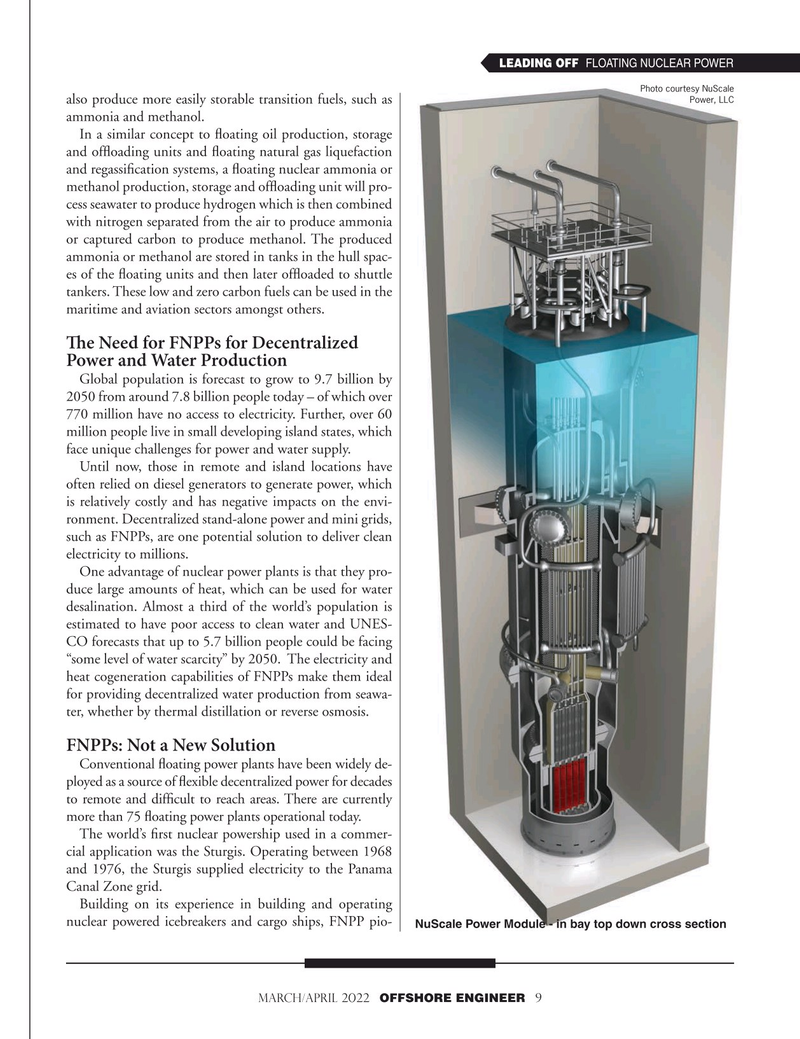
Page 9: of Offshore Engineer Magazine (Mar/Apr 2022)
Read this page in Pdf, Flash or Html5 edition of Mar/Apr 2022 Offshore Engineer Magazine
LEADING OFF FLOATING NUCLEAR POWER
Photo courtesy NuScale
Power, LLC also produce more easily storable transition fuels, such as ammonia and methanol.
In a similar concept to ? oating oil production, storage and of? oading units and ? oating natural gas liquefaction and regassi? cation systems, a ? oating nuclear ammonia or methanol production, storage and of? oading unit will pro- cess seawater to produce hydrogen which is then combined with nitrogen separated from the air to produce ammonia or captured carbon to produce methanol. The produced ammonia or methanol are stored in tanks in the hull spac- es of the ? oating units and then later of? oaded to shuttle tankers. These low and zero carbon fuels can be used in the maritime and aviation sectors amongst others.
T e Need for FNPPs for Decentralized
Power and Water Production
Global population is forecast to grow to 9.7 billion by 2050 from around 7.8 billion people today – of which over 770 million have no access to electricity. Further, over 60 million people live in small developing island states, which face unique challenges for power and water supply.
Until now, those in remote and island locations have often relied on diesel generators to generate power, which is relatively costly and has negative impacts on the envi- ronment. Decentralized stand-alone power and mini grids, such as FNPPs, are one potential solution to deliver clean electricity to millions.
One advantage of nuclear power plants is that they pro- duce large amounts of heat, which can be used for water desalination. Almost a third of the world’s population is estimated to have poor access to clean water and UNES-
CO forecasts that up to 5.7 billion people could be facing “some level of water scarcity” by 2050. The electricity and heat cogeneration capabilities of FNPPs make them ideal for providing decentralized water production from seawa- ter, whether by thermal distillation or reverse osmosis.
FNPPs: Not a New Solution
Conventional ? oating power plants have been widely de- ployed as a source of ? exible decentralized power for decades to remote and dif? cult to reach areas. There are currently more than 75 ? oating power plants operational today.
The world’s ? rst nuclear powership used in a commer- cial application was the Sturgis. Operating between 1968 and 1976, the Sturgis supplied electricity to the Panama
Canal Zone grid.
Building on its experience in building and operating nuclear powered icebreakers and cargo ships, FNPP pio-
NuScale Power Module - in bay top down cross section march/april 2022 OFFSHORE ENGINEER 9

 8
8

 10
10